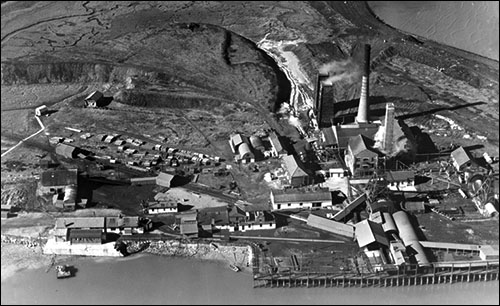Site of Point of Ayr Colliery, Talacre
![]()
![]() Site of Point of Ayr Colliery, Talacre
Site of Point of Ayr Colliery, Talacre
Here the Wales Coast Path skirts the site of Point of Ayr Colliery, closed in 1996. The colliery was so close to the sea that during a storm in 1892 colliers were prevented from going underground until the tide had ebbed – in case the sea poured into the mineshaft!
Coal was mined along this section of the coast for centuries. Point of Ayr Colliery opened in the 1880s in an area known as Parlwr Du (“Black Parlour”). Two shafts (vertical holes) were dug to access coal seams under the sea. The coal went directly into waiting ships, for carriage to various Irish Sea ports.
Railway sidings were opened in April 1909. This enabled the colliery to supply coal at competitive prices to many places, including the rest of North Wales (previously supplied from Staffordshire and Lancashire).
The aerial photo, courtesy of the Royal Commission on the Ancient & Historical Monuments of Wales, shows the colliery in 1950. It is from the Aerofilms Collection of the National Monuments Record of Wales.
Many accidents occurred at the colliery. In 1899 an explosion killed manager Lewis Jenkins and his deputy Samuel Pearson, both aged 46. They had descended with an inspection party following an earlier explosion. Lewis left a widow and three children, Samuel seven children and a widow. See below for more about accident victims.
In 1909 one of the colliery’s most productive coal seams had to be bricked up because it had caught fire. About 150 workers were laid off as a result.
The colliery was modernised in the 1950s with a third shaft and a new engine house containing electric winding gear, powered by a generator which burned diesel or methane piped up from the pit. The colliery continued to use pit ponies for haulage underground. They responded only to commands in Welsh!
In the post-war decades, most of the coal went by train to power stations. Coal was hewn more than 400 metres below the sea, and up to 3km (1.9 miles) away from the shafts.
Part of the colliery site now hosts a terminal which receives natural gas by pipeline from Liverpool Bay. The gas is piped to Connah’s Quay power station.
View Location Map
Copies of the old photo and other images are available from the RCAHMW. Contact: nmr.wales@rcahmw.gov.uk
Footnotes: More Point of Ayr Colliery accidents
In 1894 two young men from Ffynnongroyw, William Hughes and Thomas Jones, were almost at the end of their shift when a section of tunnel roof collapsed, killing them and injuring two colleagues.
In 1903 Mostyn resident Peter Parry, 61, was cutting coal when the face suddenly flew towards him “like a shot from a gun”, killing him. His son, who worked alongside him, was lucky to survive.
In 1905 a court ordered the colliery company to pay £150 compensation to Harriet Parry for the death of her son, who had injured a finger at work and died of blood poisoning.
In 1908 underground manager Thomas Bates Gregory died at home of injuries sustained when he was struck in the chest by empty “tubs” (colliery wagons). He left four children. Three weeks after his funeral in Llanasa, his brother Henry, who had not yet returned home to South Yorkshire, collapsed and died at the family home in Point of Ayr.
In 1909 the company had to pay £275 to Frances Davies or Gwespyr, whose husband had died of tuberculosis following an ankle injury at the colliery.


